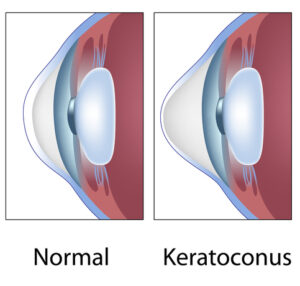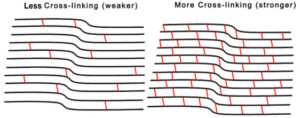If you suffer from keratoconus, your eye doctor may recommend a treatment called corneal cross-linking to slow down the condition’s progress. Before having any eye surgery, it’s necessary to understand what’s involved.
At RGB Eye Associates, we’re dedicated to providing our patients with only the best medical and surgical treatment available, whether in the form of corneal cross-linking or other care.
What is Keratoconus?

Keratoconus is an eye condition that occurs when your cornea begins thinning out. When this happens, it starts changing shape, bulging, and may look cone-shaped. As the cornea changes shape, it causes your vision to become blurry.
If your keratoconus is mild, your eye doctor may prescribe eyeglasses or contact lenses to correct your vision. But if your eyesight continues to get worse, your eye doctor may recommend other treatments such as corneal cross-linking.
What is Corneal Cross-Linking?
Corneal cross-linking is a treatment for keratoconus that strengthens the collagen in the cornea. Collagen is a natural protein in the cornea that helps provide structure.
The cross-linking procedure causes the collagen fibers to bond, strengthening the structure of the cornea and making it more stable.
Cross-linking won’t make your cornea return to a rounded shape, but it can keep your keratoconus from getting worse.
In addition, undergoing corneal cross-linking may prevent you from needing a corneal transplant, a major surgical procedure.
What Happens During a Corneal Cross-Linking Procedure?
Corneal cross-linking is an outpatient procedure. Your eye doctor at RGB Eye Associates can perform this in-office.
The treatment takes about an hour to 90 minutes. Because corneal cross-linking is an outpatient procedure, you’ll be able to go home after it’s over.

Corneal cross-linking uses riboflavin, also called vitamin B2, and ultraviolet light to help strengthen the collagen in your eyes. Before starting the procedure, your eye doctor will have you lie down and put numbing drops in your eyes.
If you’re nervous, your ophthalmologist may also give you a sedative to reduce any anxiety and help you calm down. Next, your eye doctor will put special riboflavin eye drops in your eyes and let them absorb into your cornea.
It usually takes about 30 minutes for your eyes to absorb the drops. After your cornea takes in the drops, your eye doctor will use a specialized device to shine ultraviolet light rays into your eye.
The light activates the riboflavin, helping to form new bonds between strands of collagen in the cornea. You may receive up to thirty minutes of light treatment.
Once the light treatment is complete, your eye doctor will place a bandage contact lens over your eye. The bandage contact lens will help protect it and help it heal.
You will not be allowed to drive yourself home after having corneal cross-linking treatment. Your vision will be blurry, so make sure you have a friend or someone in your family who can get you home.
What is the Recovery Process After Undergoing Corneal Cross-Linking Treatment?
It’s important to follow all instructions from your eye doctor while your eyes are healing after having corneal cross-linking. A crucial component of your recovery will be using prescription eye drops.
Make sure you take them as directed. Let your eye doctor know if you have any issues or if you’re experiencing any pain. Feeling any pain could be a sign of a complication or an infection. For the best possible recovery, avoid the following until your eye doctor clears you:
- Rubbing your eyes
- Applying or wearing eye makeup
- Getting water in your eyes
- Heavy exercise
- Smoky or dusty areas
Are There any Side Effects After Having Corneal Cross-Linking?
After treatment, you may feel some mild discomfort. Common complaints after the procedure include:
- Dry eye
- Sensitivity to light
- A sensation like there’s something in your eye
- Blurry vision
- Mild pain in your eye
Your eye doctor can prescribe medication to help with any mild discomfort. Contact your eye doctor immediately if you have severe eye pain or experience a sudden change in your vision, including losing your ability to see.
You should also call your eye doctor if the bandage contact lens falls out of your eye. Do not try to put the contact back in.
How Long Does It Take to Recover After Corneal Cross-Linking?
Although every patient is different, most people can start returning to their usual activities about a week after corneal cross-linking. It’s best to check with your eye doctor to find out when you can resume these.
However, your vision may not settle into its new normal for several months. Right after having corneal cross-linking, you may notice that your eyesight is blurry and unstable.
As your eyes heal, you may notice that your prescription fluctuates. It’s not unusual to become more sensitive to light and for your vision to be poorer for 1-3 months after having corneal cross-linking.
Your eye doctor may wait to write you a new prescription for glasses or contact lenses until they are sure your eyes have stabilized.
Who Can Benefit from Corneal Cross-Linking?
The procedure works best if your keratoconus isn’t too advanced. If performed early, having corneal cross-linking can prevent the cornea from becoming too distorted and significantly damaging vision.
Discuss your condition with your eye doctor to determine if corneal cross-linking could help you.
Are There Different Kinds of Corneal Cross-Linking?
There are two kinds of corneal cross-linking. The difference between them is what happens to the epithelium, the cornea’s outer layer.
In the epithelium-off (epi-off) procedure, your eye doctor removes the epithelium before applying the eye drops. Removing the epithelium helps improve absorption in the cornea.
In the epi-on procedure, the epithelium remains in place. Your eye doctor will loosen the epithelium using eye drops or a sponge before putting in drops and leaving the epithelium attached. Currently, this is considered an experimental treatment.
Are you searching for an ophthalmologist to treat keratoconus or other vision problems? Contact RGB Cataract and LASIK in Sherman, TX at 903-892-3282 to schedule an appointment with one of our eye doctors.






